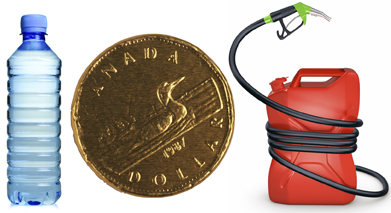Lesson 1
1. Lesson 1
1.4. Discover 2
Module 6: Proportional Reasoning
People use rates every day to help them get the best value on their purchases. For example, many of the decisions that have to be made during the moving process can be made by comparing rates. Rates and unit rates can help determine which moving company is the most cost effective, which type of snack for the road is the best buy, which vehicle has the best fuel consumption, or who can pack the fastest.
Consider the following situation.

Comstock/
Thinkstock
Rajesh and his family are preparing to move to a new city. As part of their move preparation, Rajesh is responsible for filling up the family vehicles with gas. His brother Kunal is responsible for picking up snacks and beverages for the drive.

water bottle: iStockphoto/Thinkstock; gas can: iStockphoto/Thinkstock; coin: Coin image © 2011 Royal Canadian Mint – All Rights Reserved
Try This 1
You should place your completed Try This activities in your course folder. Your teacher may ask to see your completed Try This activities. For more information on Try This activities, refer to the Course Introduction.
It costs Rajesh $53.02 to put 55 L of fuel in his mom’s car. It costs Kunal $5.64 for a pack of 12 500-mL water bottles. Kunal makes the comment that bottled water is actually more expensive than fuel. Rajesh thinks he is wrong. Rajesh says that fuel costs more than bottled water.
- Compare the cost of the fuel to the cost of the bottled water.
- Do you agree with Kunal or with Rajesh? Explain your reasoning.
Share 1
After a discussion with your teacher, you will decide how to connect with other students for Share activities. Follow your teacher’s instructions to complete this Share activity. Place a summary of your Share discussion in your course folder. For more information on Share discussions, refer to the Course Introduction.
Share your comparisons from Try This 1 with another student or appropriate partner. Consider the following:
- What methods did you each use to compare the cost of fuel to the cost of the bottled water? How were the methods similar? How were they different?
- Describe your conclusions about whether Kunal or Rajesh was correct. What was the reasoning behind your decisions?